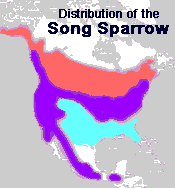Song Sparrows Have
Well Defined Distributions
 The distribution of a plant or animal is the geographic area over which the species is found during at least one part of the year. The "distribution map" at the right is typical of many migratory birds. In this map the area where the Song Sparrow is found only during the summer is shown in red. Purple marks where the species exists year round. The area shown in turquoise delimits where the bird is found only during the winter. People living in the purple may see Song Sparrows all year round, but they are not necessarily the same birds. During the summer, for instance, someone in Chicago, may see Song Sparrows who spent their winter in my area, southern Mississippi, but during the winter that Chicagoan may see Song Sparrows who spent their summer up in Canada near Hudson's Bay.
The distribution of a plant or animal is the geographic area over which the species is found during at least one part of the year. The "distribution map" at the right is typical of many migratory birds. In this map the area where the Song Sparrow is found only during the summer is shown in red. Purple marks where the species exists year round. The area shown in turquoise delimits where the bird is found only during the winter. People living in the purple may see Song Sparrows all year round, but they are not necessarily the same birds. During the summer, for instance, someone in Chicago, may see Song Sparrows who spent their winter in my area, southern Mississippi, but during the winter that Chicagoan may see Song Sparrows who spent their summer up in Canada near Hudson's Bay.
The distributions of most North American sparrows are much smaller. Brewer's Sparrows, for instance, are found only in western North America, in sagebrush and desert scrub. This is the way it is with most kinds of plants and animals. A few species are common in many places, a few are found only in some very local spots, but most have "medium" distributions -- the area covered by Eastern North America's deciduous forests, for instance.
Some mammals and even a few insects migrate, but we backyard naturalists mainly notice migration among birds. Many bird species migrate much longer distances than Song Sparrows. American Golden Plovers, for instance, nest in the Arctic but winter along the coast of Brazil, and on the Argentine pampas.
Return to Life Cycle Index Page
 The distribution of a plant or animal is the geographic area over which the species is found during at least one part of the year. The "distribution map" at the right is typical of many migratory birds. In this map the area where the Song Sparrow is found only during the summer is shown in red. Purple marks where the species exists year round. The area shown in turquoise delimits where the bird is found only during the winter. People living in the purple may see Song Sparrows all year round, but they are not necessarily the same birds. During the summer, for instance, someone in Chicago, may see Song Sparrows who spent their winter in my area, southern Mississippi, but during the winter that Chicagoan may see Song Sparrows who spent their summer up in Canada near Hudson's Bay.
The distribution of a plant or animal is the geographic area over which the species is found during at least one part of the year. The "distribution map" at the right is typical of many migratory birds. In this map the area where the Song Sparrow is found only during the summer is shown in red. Purple marks where the species exists year round. The area shown in turquoise delimits where the bird is found only during the winter. People living in the purple may see Song Sparrows all year round, but they are not necessarily the same birds. During the summer, for instance, someone in Chicago, may see Song Sparrows who spent their winter in my area, southern Mississippi, but during the winter that Chicagoan may see Song Sparrows who spent their summer up in Canada near Hudson's Bay.